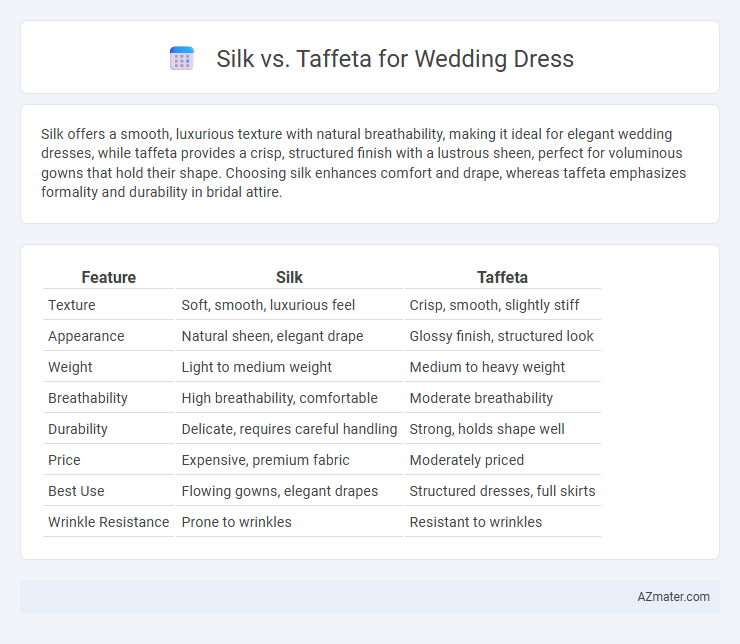Silk offers a smooth, luxurious texture with natural breathability, making it ideal for elegant wedding dresses, while taffeta provides a crisp, structured finish with a lustrous sheen, perfect for voluminous gowns that hold their shape. Choosing silk enhances comfort and drape, whereas taffeta emphasizes formality and durability in bridal attire.
Table of Comparison
| Feature | Silk | Taffeta |
|---|---|---|
| Texture | Soft, smooth, luxurious feel | Crisp, smooth, slightly stiff |
| Appearance | Natural sheen, elegant drape | Glossy finish, structured look |
| Weight | Light to medium weight | Medium to heavy weight |
| Breathability | High breathability, comfortable | Moderate breathability |
| Durability | Delicate, requires careful handling | Strong, holds shape well |
| Price | Expensive, premium fabric | Moderately priced |
| Best Use | Flowing gowns, elegant drapes | Structured dresses, full skirts |
| Wrinkle Resistance | Prone to wrinkles | Resistant to wrinkles |
Introduction: Choosing the Perfect Wedding Dress Fabric
Silk and taffeta stand out as premier fabrics for wedding dresses, each offering unique textures and finishes that influence the gown's overall elegance. Silk provides a natural sheen and smooth drape, lending a timeless, luxurious appearance ideal for classic or sophisticated styles. Taffeta, characterized by its crisp texture and subtle sheen, creates structured silhouettes perfect for voluminous skirts and modern designs.
Understanding Silk: Characteristics and Appeal
Silk, a natural protein fiber produced by silkworms, is prized for its luxurious softness, natural sheen, and excellent drape, making it a popular choice for wedding dresses. Its breathable, hypoallergenic qualities provide comfort throughout long ceremonies, while the rich texture enhances elegant silhouettes and intricate designs. Silk's timeless appeal lies in its ability to blend durability with refined aesthetics, ensuring a radiant, sophisticated look for brides.
What is Taffeta? An Overview
Taffeta is a crisp, smooth woven fabric made primarily from silk or synthetic fibers, known for its lustrous sheen and structured drape. Commonly used in wedding dresses, taffeta offers a luxurious texture with a slightly stiff feel that holds shape well, making it ideal for voluminous skirts and tailored bodices. Its unique rustling sound and shimmering finish provide an elegant, sophisticated appearance that contrasts with the softer, flowing qualities of silk satin.
Texture and Feel: Silk vs Taffeta
Silk offers a smooth, luxurious texture that feels soft and breathable against the skin, making it ideal for a comfortable, elegant wedding dress. Taffeta, by contrast, has a crisp, slightly stiff texture with a slight sheen, creating a structured silhouette that holds its shape well. The choice between silk's natural fluidity and taffeta's firm body significantly impacts the dress's overall feel and movement on the big day.
Appearance: Shine, Drape, and Structure
Silk wedding dresses offer a natural sheen that radiates understated elegance, with a soft drape that flows gently around the body, creating a romantic silhouette ideal for classic bridal looks. Taffeta, known for its crisp texture and lustrous shine, provides a structured appearance that holds shape well, making it perfect for voluminous skirts and sculpted designs. The contrast between silk's fluidity and taffeta's formality enhances dress aesthetics, influencing choice based on desired style and movement.
Comfort and Breathability Comparison
Silk offers superior comfort and breathability for wedding dresses due to its natural protein fibers that regulate temperature and wick moisture away from the skin. Taffeta, typically made from silk or synthetic fibers, tends to be stiffer and less breathable, resulting in a less comfortable wearing experience during long ceremonies. Brides prioritizing softness and airflow often prefer silk for its lightweight feel and enhanced ventilation properties.
Durability and Maintenance Requirements
Silk wedding dresses offer natural strength and a luxurious feel but require delicate care, including dry cleaning and careful storage to prevent damage from moisture and sunlight. Taffeta, known for its crisp texture and sheen, is highly durable and resists wrinkles, making it easier to maintain with minimal professional cleaning. For long-term durability and low-maintenance wear, taffeta is often preferred, while silk provides elegance with a need for more attentive upkeep.
Ideal Wedding Dress Styles for Silk and Taffeta
Silk's smooth, luxurious texture suits flowing, elegant wedding dress styles such as A-line and bias-cut gowns, enhancing natural drape and movement. Taffeta's crisp, structured fabric works best for ball gowns and fit-and-flare designs, providing volume and shape with its slight sheen and stiffness. Brides seeking a romantic yet structured silhouette often choose taffeta, while those favoring soft, fluid lines prefer silk.
Budget Considerations: Cost Differences
Silk wedding dresses generally have a higher price point due to the natural fiber's luxurious texture and intricate production process, with costs ranging from $1,000 to $10,000 or more. Taffeta, a synthetic or silk blend fabric, offers a more affordable option, often priced between $500 and $3,000, making it ideal for budget-conscious brides. The choice between silk and taffeta significantly impacts the overall wedding dress budget, as silk demands premium craftsmanship and sourcing compared to the more cost-effective taffeta.
Final Verdict: Which Fabric Suits Your Dream Dress?
Silk offers a luxurious, natural sheen and breathability, making it ideal for a timeless, elegant wedding dress that feels comfortable throughout the day. Taffeta, known for its crisp texture and structured form, suits brides seeking a voluminous, dramatic silhouette with a slight shimmer. Choosing between silk and taffeta depends on your desired wedding dress style, climate, and how much body or drape you want in the fabric to create your perfect look.

Infographic: Silk vs Taffeta for Wedding Dress
 azmater.com
azmater.com